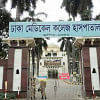Hospitals in grave peril

Two of the country's largest public health facilities -- Dhaka Medical College Hospital and Mitford Hospital -- might not be able to withstand an earthquake of seven magnitude on the Richter scale.
Dwellers of Dhaka, which according to experts is vulnerable in the event of an earthquake, might not have the facilities of these two hospitals available in such an eventuality.
Experts are worried who would cater to the city dwellers' healthcare and emergency services needs if both the hospitals came crashing down. But the problem is much bigger as many of the country's healthcare facilities are ill-equipped to handle the aftermath of a major earthquake.
A recent fire department survey found as many as 174 out of a total 433 healthcare providing establishments surveyed to be highly risky (with no fire safety necessities), 248 risky (with some fire safety measures installed) and the rest satisfactory (mostly compliant with some minor lapses).
Experts said neither DMCH nor Mitford has an effective evacuation plan, fire exits or ramps. The decades-old structures, despite numerous modifications, have never been refurbished or strengthened in any way.
Government and hospital officials also agree that the hospitals themselves were vulnerable and were ill-prepared, ill-equipped with untrained manpower to deal with such a disaster.
Brig Gen Ali Ahmed Khan, director general of Fire Service and Civil Defence, said most of the state-run hospitals in the capital were vulnerable to earthquakes and there was a serious lack of fire-safety and evacuation system.
He said fundamental safety provisions that the two hospitals lack include evacuation ramp, fire exit plan, fire detection and alarm systems, hose reels, safe refuge assembly space, trained in-house firefighting team, fire escape route, fire lift, access road and water reservoir.
During a visit to the hospitals, many areas of the buildings were visibly worn out and staircases and corridors were full of patients. There was no disaster evacuation preparedness whatsoever.
Brig Gen Brayan Bankim Halder, director of Mitford Hospital, said they had made a project proposal on constructing a 16-storey building demolishing the risky medicine building.
“Mitford itself is at a big risk [in the event of an earthquake] as it has some old buildings, main building and medicine building are very old.”
He said the hospital did not have a dedicated rescue team, adding, “The hospital is overburdened as everyday it has to deal with around 4,000 outdoor patients, 1,200 indoor patients and 50 surgeries. We have limited resources and capacity, even after that we make people aware sometimes and practice standard procedures. But I doubt whether the standard procedures will work when a big disaster happens.”
The DMCH has a 28-member mass casualty management committee to deal with disasters and the committee has many sub-committees.
AKM Nasiruddin, director of DMCH, said the old buildings of the hospital were risky and those might collapse if there was a big one.
“If the hospital is affected, then we will shift to the new building and health services would be provided out in the open. The outdoor complex will start giving initial healthcare services to about 300 patients at a time.”
When asked whether the hospital officials were prepared and equipped for facing a big one, he said, “One major problem is that we cannot do drills like other organisations because it might create panic among the patients and might create another disaster. Our people are aware … .”
He said there is a shortage of ambulances at the hospital. It has only seven. Since the DMCH will turn into the centre for medical service during a disaster, more ambulances are needed.
Nasiruddin said during an emergency period, the hospital would need more portable equipment, like portable X-ray machines, portable beds, and portable operation lights.
The hospital conducts disaster-preparedness training but most staff members have not been trained to deal with a catastrophic quake. He said a major disaster would be a national issue requiring a national response.
The fire services DG said they have sent letters to almost all hospitals asking them to strengthen the emergency services as they would provide the basic support if any emergency situation developed.
“Hospitals should have a huge blood bank because after any disaster a lot of blood will be required. Hospital services have to be decentralised and hospitals should have mobile hospital facilities,” he said.

 For all latest news, follow The Daily Star's Google News channel.
For all latest news, follow The Daily Star's Google News channel. 








Comments